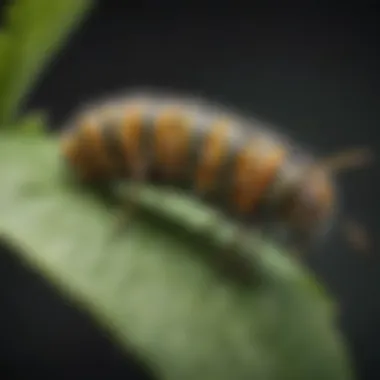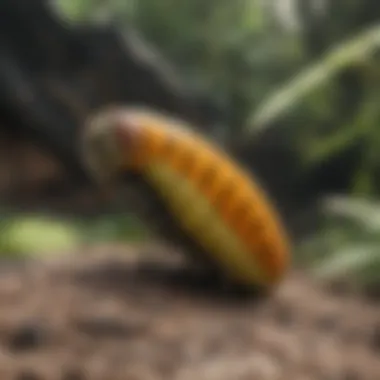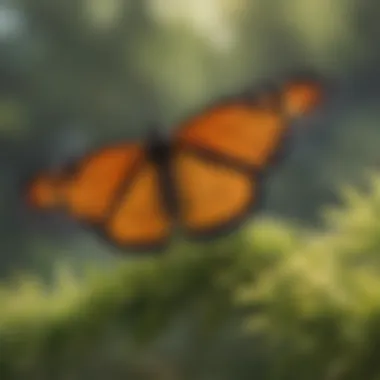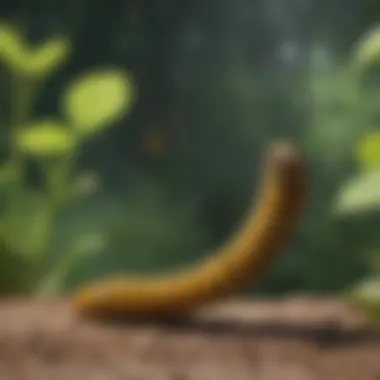Where to Buy Monarch Butterfly Caterpillars: A Guide


Nature Topic Overview
Monarch butterflies are fascinating creatures that undergo a remarkable transformation from caterpillar to chrysalis and finally to a beautiful butterfly. Understanding where to find monarch butterfly caterpillars helps to educate children and adults about their life cycle. This knowledge not only inspires curiosity but also promotes an appreciation for nature. In this guide, we will explore various sources where you can acquire these caterpillars, emphasizing the significance of responsible sourcing and care.
Importance of Monarch Butterflies
Monarch butterflies play an essential role in our ecosystem. They are pollinators, which means they help in the reproduction of various plants. They also serve as indicators of environmental health. Watching their life cycle captivates young minds, making it a valuable educational experience.
Fun Facts and Trivia
Here are some fun facts about monarch butterflies that can engage young readers:
- Migration: Monarchs migrate thousands of miles each year from North America to Mexico.
- Lifespan: Monarch caterpillars can live for about 10 days, while adult butterflies can live up to 8 months.
- Taste: Monarch caterpillars gain their bright coloration from the milkweed plants they eat, which makes them unappetizing to predators.
Interactive Elements
Consider creating a butterfly journal to document the growth of your caterpillars, including drawings and notes about their behavior.
Wildlife Explorations
Monarch butterflies are not alone in the habitat they thrive in. Other species related to them include:
- Milkweed plants: The primary food source for monarch caterpillars.
- Swallowtails: Another type of butterfly that can be found in similar environments.
Each of these species contributes to the biodiversity in their habitat. Engaging in explorations to identify various species can enhance your understanding of local ecosystems.
Interactive Features
To make learning exciting, consider a quiz about the differences between various butterfly species. This will encourage observation and retention of information about wildlife.
Environmental Awareness
Raising monarch butterflies offers an excellent opportunity to educate about conservation. Monarch populations have declined significantly due to habitat loss, climate change, and pesticide use.
Tips for Kids to Help Nature
- Plant milkweed in your garden to support monarchs.
- Avoid using chemical pesticides to maintain a healthy environment for all species.
- Participate in local conservation activities to protect butterfly habitats.
DIY Nature Activities
Hands-on activities can make learning about monarch caterpillars more engaging for children. Here are some suggested activities:
- Build a Butterfly Garden: Create a small garden using milkweed and nectar plants to attract monarchs.
- Craft Butterfly Lifecycles: Use colored paper or clay to create models of the different stages of the monarch life cycle.
Outdoor Explorations
Plan a field trip to a local park or nature reserve to identify butterflies and plants like milkweed in their natural habitat. A nature walk can provide valuable real-world experience concerning the importance of these butterflies in our ecosystem.
"Conservation is a state of harmony between men and land." - Aldo Leopold
Prologue to Monarch Butterflies
Monarch butterflies are not merely a beautiful sight in gardens; they hold significant ecological roles and serve as critical indicators of environmental health. This article focuses on raising awareness about monarch butterflies with an emphasis on their caterpillars. By understanding the importance of these insects, readers will gain insights into where to acquire them responsibly for educational purposes.
A crucial part of this exploration is understanding the lifecycle of the monarch. Monarch caterpillars undergo a remarkable transformation, which can be a fascinating subject for children and adults alike. Witnessing this metamorphosis creates opportunities for hands-on learning and appreciation of nature’s processes.
Additionally, monarch butterflies contribute to ecosystems in various ways. They pollinate plants and serve as a food source for other wildlife. Their declining populations signal environmental issues, prompting a need for conservation efforts. By engaging with them, individuals can practice stewardship of the environment and become more aware of their impact on nature.
In essence, raising monarch caterpillars can merge enjoyment with education, fostering a new generation of nature enthusiasts.
Understanding the Monarch Life Cycle


The monarch life cycle consists of four distinct stages. Beginning as an egg, they hatch into caterpillars, then pupate into chrysalises, and finally emerge as butterflies. Each stage offers unique learning opportunities. For instance, observing the transformation from caterpillar to chrysalis involves patience and curiosity, as it may take several days.
During the caterpillar stage, which typically lasts about two weeks, these creatures feed extensively on milkweed. Observing their eating habits can teach children about the importance of a suitable diet for growth. The chrysalises, on the other hand, are fascinating in their stillness. Inside, significant changes occur, culminating in the emergence of the adult butterfly.
Importance of Monarch Butterflies in the Ecosystem
Monarch butterflies play a vital role in the ecosystem. They are pollinators, helping in the reproduction of various flowering plants. As they transfer pollen, they support biodiversity. This not only benefits the plants but also the larger animal populations that depend on these plants for food and shelter.
Moreover, monarchs serve as a food source for birds and other predators. Their presence in numerous habitats indicates a wider ecological balance. When monarch numbers decline, it can signal changes in environmental conditions, often linked to habitat loss or climate change.
In summary, understanding the monarch butterfly is crucial for grasping their role in ecosystems and the importance of preserving their habitats.
"Monarchs are a vital link in our ecosystem, and their decline affects many plants and animals."
By learning about their life cycle and ecological importance, individuals can better appreciate these remarkable insects.
The Value of Raising Caterpillars
Raising caterpillars, especially those of the monarch butterfly, holds significant value. This process dazzles both children and adults with the wonders of nature. Not only does it facilitate biodiversity education, but it also encourages individuals to connect closely with the natural world. As people observe caterpillars transform into magnificent butterflies, they grasp essential biological concepts and develop a sense of responsibility toward the environment. This experience can nurture a lifelong interest in science and nature.
Educational Benefits for Children
One of the main advantages of raising caterpillars is the educational benefits for children. Engaging in hands-on activities enhances learning. Children can witness the life cycle in real-time, progressing from caterpillar to chrysalis and finally to butterfly. This visual and experiential learning reinforces science concepts taught in the classroom.
Encouraging curiosity about nature can help develop critical thinking skills as children ask questions about the different stages of the monarch's life cycle. They may wonder how long it takes for a caterpillar to transform or what it eats at different stages. These questions lead to searching for answers, stimulating the child's mind and promoting research skills.
Furthermore, discussing the different aspects of caterpillar care can teach responsibility. Children learn to monitor the caterpillars' diet, habitat preferences, and overall well-being, fostering an understanding of caring for living creatures.
Promoting Environmental Awareness
Raising monarch butterfly caterpillars promotes environmental awareness among both children and adults. Understanding the ecological role of monarchs highlights their importance in pollination and ecosystem balance. Engaging with wildlife encourages discussions about habitats, conservation efforts, and the impact of human activities on these fragile populations.
In a practical sense, children who raise caterpillars often feel a connection to biodiversity preservation. This can motivate them to take part in local conservation efforts. Encouraging outdoor exploration reinforces awareness about the environment.
Moreover, discussions about the threats facing monarch butterflies can lead to meaningful conversations about habitat restoration and the significance of native plants. Learning about the impact of pesticides, climate change, and urbanization cultivates empathy and responsibility. Children can go from merely observing nature to becoming advocates for it.
"Raising caterpillars is not just about butterflies. It is a journey into understanding nature's delicate balance."
By encouraging children to engage with the process of raising monarch caterpillars, we lay the foundation for informed future citizens who care about and actively contribute to environmental health.
Understanding where to source monarch butterfly caterpillars is vital for anyone wishing to raise these remarkable creatures. This section examines the various options available for purchasing caterpillars. Selecting the right source is crucial not only for the health of the caterpillars but also for ensuring educational success. When acquiring caterpillars, consider the aspects of care, habitat, and the integrity of the sources. Responsible sourcing contributes to a meaningful learning experience while fostering a connection with nature.
Online Retailers
Online platforms provide a convenient and often diverse selection of monarch butterfly caterpillars. Websites like Bumblebee Conservation Trust and Insect Lore offer caterpillars for sale along with supplies needed for their care.
When purchasing from online retailers, pay attention to customer reviews and ratings. Reviews can provide insight into the health and viability of the caterpillars. Importantly, verify the delivery policies and timings. Caterpillars are sensitive to temperature fluctuations, and long shipping times may affect their wellbeing.
Here are some benefits of purchasing online:
- Variety: Specialized online shops often have a wider selection of caterpillar stages.
- Education: Many sellers include care guides with their products.
- Convenience: Shopping from home can save time and effort.
It is also essential to confirm that the retailer follows ethical practices in sourcing their caterpillars.
Local Garden Centers
Local garden centers present another great option for obtaining monarch butterfly caterpillars. Many centers support local ecosystems and provide caterpillars that are adapted to the local environment. In addition to live caterpillars, garden centers often carry related accessories.
Visiting a local store has its advantages:
- Personal Interaction: You can speak directly with knowledgeable staff regarding care.
- Immediate Availability: No shipping delays; you can inspect caterpillars firsthand.
- Community Connection: Supporting local businesses helps promote community efforts towards conservation.


Engaging with local centers also fosters a sense of responsibility and encourages conversations about ecological preservation.
Specialty Butterfly Farms
Specialty butterfly farms often offer an excellent choice for sourcing monarch caterpillars. These farms focus on breeding and raising various butterfly species. As such, they are usually well-informed about the life stages and ecological needs of the butterflies.
Benefits of choosing specialty farms include:
- Expert Knowledge: Staff can provide detailed guidance on raising caterpillars.
- Quality Assurance: Farms typically monitor the health of their insects closely at all life stages.
- Conservation Ethics: Many farms are involved in breeding programs aimed at increasing butterfly populations.
Before purchasing, inquire about their breeding practices and whether they participate in conservation efforts. This ensures your choice supports responsible butterfly farming practices.
Considerations When Purchasing Caterpillars
When looking to buy monarch butterfly caterpillars, several considerations can greatly affect your experience and the success of your endeavor. Understanding these factors helps ensure that you not only acquire healthy caterpillars but also contribute to their well-being and the environment.
Choosing the right caterpillars can impact both their development and your educational objectives. This section outlines the essential elements you should keep in mind while purchasing caterpillars, ensuring you make informed decisions that benefit these fascinating creatures and enhance your learning experience.
Choosing Healthy Caterpillars
Selecting healthy caterpillars is fundamental to raising monarchs successfully. Healthy caterpillars are usually active, exhibit vibrant coloration, and do not show signs of disease or deformity. Here are some pointers to help in your selection:
- Physical Appearance: Check for bright coloring. Dull or faded caterpillars may indicate stress or illness.
- Movement: Observe their behavior. Healthy caterpillars should be active and responsive.
- Feeding Habits: Caterpillars should be feeding regularly on milkweed, which is their primary diet. Look for signs that they are munching on leaves.
Ultimately, the health of the caterpillars you choose will determine how well they thrive in your care.
Confirming Species and Lifecycle Stage
Before making a purchase, it is crucial to confirm the exact species and lifecycle stage of the caterpillars. Monarch butterflies go through several stages: egg, larva (caterpillar), pupa (chrysalis), and adult butterfly. Each stage requires different care and conditions. Here are some things to consider:
- Species Verification: Ensure that you are purchasing Danaus plexippus, the scientific name for monarch butterflies. Confusing them with other species can impact educational outcomes and conservation efforts.
- Lifecycle Stage: Caterpillars are generally available in different stages – first instar (young) or fifth instar (older). Each stage has specific habitat and feeding needs. Knowing their stage ensures you prepare adequately. For instance, first instar caterpillars require more careful feeding and habitat management than fifth instar ones, which are more resilient.
By taking these considerations into account, you not only prepare for a successful experience in raising monarch caterpillars but also foster a deeper appreciation for their unique life cycle and environmental role.
Caring for Monarch Caterpillars
Taking care of monarch caterpillars is not only about providing food and space. It is also about understanding their needs and developing a connection with nature. Monarchs are fascinating creatures that offer insights into the life cycle and ecological balance. Caring for them can be a rewarding experience, especially for children. However, it requires attention to detail and a structured approach.
Creating the Ideal Habitat
A suitable habitat is crucial for the well-being of monarch caterpillars. Monarchs thrive in specific environments that replicate their natural conditions. When setting up a habitat, consider the following:
- Container Choice: Use a breathable enclosure like a mesh butterfly house or a small aquarium with a ventilated lid.
- Plant Selection: Milkweed is essential as it is the primary food source for monarch caterpillars. Various milkweed species, such as common milkweed (Asclepias Syriaca) or tropical milkweed (Asclepias Currassavica), work well.
- Humidity and Temperature: Keep the habitat in a warm spot, ideally between 70°F to 85°F. A consistent temperature is vital for their growth.
Create a space that mimics the outdoors. Adding fresh leaves, water sources, and occasional sunlight will provide a comfortable atmosphere.
Feeding and Maintenance
Feeding monarch caterpillars requires diligence. Fresh milkweed leaves should be the main diet. Here are essential points regarding feeding and maintenance:
- Freshness Matters: Always provide fresh milkweed leaves. Caterpillars are picky eaters and need tender, undamaged leaves.
- Quantity: Depending on the number of caterpillars, ensure there is enough food. Each caterpillar can eat a significant amount as they grow.
- Cleaning: Regularly clean the enclosure. Remove dried leaves and caterpillar waste to prevent bacterial growth, which can affect their health.
Keep monitoring the food supply. If you see them not eating, check if the leaves are fresh. Caterpillars eat a lot; it's a sign of their healthy growth.
Monitoring Health and Development
Keeping an eye on the health of caterpillars is critical. Observing their development will help determine if they are thriving:
- Physical Appearance: Healthy caterpillars are vibrant and show no signs of discoloration. If you notice black or brown spots, that might indicate disease.
- Behavior: Monitor their activity level. Active caterpillars tend to be healthy, while lethargic ones may need attention.
- Development Stages: Understand the stages of growth. Caterpillars typically molt five times before becoming pupae. Each stage may require different care considerations.
"Monitoring their growth stages helps provide the right environment at the right time."


Remember: The life cycle of a monarch butterfly is a direct reflection of your attentiveness in their care. Caring for monarch caterpillars is a fulfilling journey that fosters understanding and admiration of these remarkable insects.
Ethical Considerations in Sourcing Caterpillars
When people want to buy monarch butterfly caterpillars, it's essential to think about the ethics behind it. This section highlights important elements that ensure caterpillars are sourced responsibly. Ethically sourced caterpillars can help in educational activities while supporting conservation efforts.
Impact on Monarch Populations
One must consider how sourcing caterpillars affects their populations. Monarch butterflies face threats from habitat loss, pollution, and climate change. If caterpillars are taken from the wild, it can harm local populations. This makes it vital to ensure that the caterpillars are bred in captivity or purchased from legitimate sources that support sustainable practices.
- Using captive-bred caterpillars helps reduce pressure on wild populations.
- Always verify that sellers have permits or certifications.
- Avoid sourcing from unregulated places to protect monarchs in the wild.
Inclusion of responsible sourcing helps ensure that these beautiful creatures continue to exist for future generations. Always think critically about the choices being made when obtaining these caterpillars.
"Responsible sourcing of monarch caterpillars is essential not just for education, but for their survival."
Contributing to Conservation Efforts
Sourcing caterpillars ethically supports broader conservation goals. Buying from reputable breeders and butterfly farms can contribute to breeding programs designed to bolster declining populations. Additionally, many organizations focus on education. By purchasing from these sources, you support their mission and conservation initiatives.
- Support local butterfly farms that engage in conservation.
- Participate in programs that track the health of butterfly populations.
- Educate others about the importance of sustainable practices.
When you source caterpillars responsibly, you participate in a larger community effort. This not only benefits the environment but fosters a spirit of collaboration among butterfly enthusiasts. Understanding the ethical considerations will help ensure both learning outcomes and environmental responsibilities are met.
Educational Resources and Activities
Educational resources are essential in fostering an appreciation for monarch butterflies among children and adults alike. Engaging materials and activities can open the door to science, ecology, and environmental stewardship. Through careful selection of books and activities, families and educators can create meaningful experiences that encourage curiosity and learning.
Books and Guides for Young Learners
Books on monarch butterflies can provide young learners with valuable insights into their fascinating life cycle and habitats. Titles like "Monarch Butterfly: A Life Cycle" by Ron Fridell and "Waiting for Wings" by Loise Ehlert offer vivid illustrations and informative narratives about these creatures. These resources help develop a foundational understanding of biology, while also igniting excitement about nature.
Selecting age-appropriate guides is important. For example, picture books are excellent for children aged five to seven, while slightly older kids can benefit from more information-dense texts. Certain books also include activities for hands-on learning, which further cultivates interest.
In addition to standalone books, online platforms such as Wikipedia and Britannica offer articles that can supplement what is learned in texts. These resources can be particularly useful for older children who may want to dive deeper into specific aspects, such as migration patterns and conservation efforts.
Hands-On Activities for Understanding Life Cycles
Hands-on activities enhance learning and retention by allowing children to directly interact with the material. Different activities can illustrate the life cycle of the monarch butterfly—from egg to caterpillar to chrysalis and finally to adult butterfly.
One popular activity is to set up a butterfly garden. This can be done on a small scale in backyards or even in community spaces. Participants can plant native milkweed, which serves as the primary host plant for monarch caterpillars. This kind of project not only teaches children about the butterflies' needs but also contributes to local conservation efforts.
Another engaging task is to rear caterpillars at home, following the care guidelines discussed in previous sections. This experience can also be documented through journals or art projects, allowing kids to reflect on their learning processes and observations.
"Creating interactive learning experiences fosters a sense of responsibility and wonder in young minds."
Additional activities may include crafting models of the life cycle, engaging in storytelling sessions, or even using digital resources such as educational websites and videos. Teachers and parents can tailor these projects to align with school curriculum goals or ecological themes.
By incorporating a blend of reading and practical activities, caregivers can cultivate a well-rounded understanding of monarch butterflies, ultimately promoting a new generation of nature enthusiasts.
The End
The Importance of Responsible Sourcing
Responsible sourcing refers to obtaining caterpillars in a way that does not harm their natural environments or their populations. This concept is vital for a few reasons:
- Preserving Ecosystems: When caterpillars are taken from their natural habitats, it can disrupt local ecosystems. Each caterpillar plays a role in its environment, and removing them can harm the delicate balance of local flora and fauna.
- Sustainable Practices: By acquiring caterpillars from ethical sources, such as certified butterfly farms or reputable online retailers, individuals can ensure that their actions do not negatively impact monarch populations. This helps maintain the species for future generations to observe and study.
- Educating Others: When individuals source their caterpillars responsibly, they become advocates for conservation. Sharing knowledge about the importance of ethical practices can inspire others to follow suit, creating a ripple effect in community awareness and engagement regarding species protection.
"Understanding the importance of sourcing responsibly helps in nurturing a sustainable relationship with our environment."
Encouraging a New Generation of Nature Enthusiasts
In today's fast-paced world, it's important to foster a connection to nature in young minds. Raising monarch caterpillars serves as a captivating introduction to biology and conservation for children aged 5-12 years. Here’s how it promotes interest in nature:
- Hands-On Learning: Children who raise caterpillars get to physically interact with the natural world. Each stage of the life cycle—from egg to caterpillar, to chrysalis, and finally, to butterfly—offers valuable hands-on learning opportunities.
- Curiosity about Nature: Observing these transformations can ignite curiosity. Children may ask questions about habitats, diets, and behaviors, leading to deeper research and understanding about butterflies and their environment.
- Building Responsibility: Caring for living creatures fosters a sense of duty and responsibility in children. They learn about the needs of the caterpillar, such as the right food and habitat, which can lead to broader discussions about animal welfare and environmental protection.
Through these experiences, children can become informed nature enthusiasts, paving the way for a generation that values and protects the natural world.







